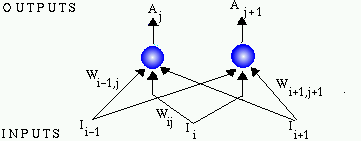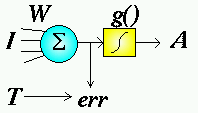Supervised learning in a single-layer neural network
Let's consider a single-layer neural network with b inputs and c
outputs:

-
Wij = weight from input i to unit j in output layer;
Wj is the vector of all the weights of the j-th neuron
in the output layer.
-
Ip = input vector (pattern p) = (I1p,
I2p, ..., Ibp).
-
Tp = target output vector (pattern p) = (T1p,
T2p, ..., Tcp).
-
Ap = Actual output vector (pattern p) = (A1p,
A2p, ..., Acp).
-
g() = sigmoid activation function: g(a ) = [1 + exp (-a)]-1
Supervised learning
We have seen that different weights of a neural network produce different
functions of the input. To train a network, we can present some sample
inputs and compare the actual output to the desired results. The
difference is called the error.
![[an error term is computed and fed back]](images/learning.gif) The different learning rules tell us which way to adjust the weights to
reduce this error. We say that training has converged when this error
reaches some small, acceptable level.
The different learning rules tell us which way to adjust the weights to
reduce this error. We say that training has converged when this error
reaches some small, acceptable level.
Often the learning rule takes the following form:
Wij (t+1) = Wij
(t) + eta . err (p)
where 0 <= eta < 1 is a parameter that controls the learning
rate, and err(p) is the error when input pattern p is presented.
[Back
to the Adaline/Perceptron/Backprop applet page]
Adaline learning
ADALINE is an acronym for ADAptive LINear Element (or ADAptive LInear NEuron).
It was developed by Bernard Widrow and Marcian Hoff (1960).
The adaline learning rule (also known as the least-mean-squares rule,
the delta rule, and the Widrow-Hoff rule) is a training rule that minimises
the output error using (approximate) gradient descent. After each training
pattern Ip is presented, the correction to apply
to the weights is proportional to the error. The correction is calculated
before the thresholding step, using errij (p)=Tp-Wij
Ip:

Thus, the weights are adjusted by
Wij (t+1) = Wij
(t) + eta (Tp-Wij Ip)
(Ip)
This corresponds to gradient descent on the quadratic error surface,
Ej=Sump [Tp - Wj
. Ip] 2
[Back
to the Adaline/Perceptron/Backprop applet page]
Perceptron learning
In perceptron learning, the weights are adjusted only when a pattern
is misclassified. The correction to the weights after
applying the training pattern p is
Wij (t+1) = Wij
(t) + eta (Tp - Ap) (Ip)
This corresponds to gradient descent on the error surface E (Wij
)= Summisclassified [Wij (Ap)(Ip)].
[Back
to the Adaline/Perceptron/Backprop applet page]
Pocket algorithm
The perceptron learning algorithm does not terminate if the learning set
is not linearly separable. In many real-world cases, however,
we want to find the "best" linear separation even when the learning sets
are not ideal. The pocket algorithm is a modification of the perceptron
rule proposed by S. I. Gallant (1990). It stores the best weight vector
so far in a "pocket" while continuing to learn. The weights are actually
modified only if a better weight vector is found.
[Back
to the Adaline/Perceptron/Backprop applet page]
Backpropagation
The backpropagation algorithm was developed for training multilayer perceptron
networks. In this applet, we will study how it works for a single-layer
network. It was popularized by Rumelhart, Hinton and Williams (1986),
although similar ideas had been developed previously by others (Werbos,
1974; Parker, 1985). The idea is to train a network by propagating
the output errors backward through the layers. The errors serve to evaluate
the derivatives of the error function with respect to the weights, which
can then be adjusted.
The backpropagation algorithm for a single-layer network using the sum-of-squares
error function consists of two phases:
-
Feedforward - apply an input; evaluate the activations aj
and store the error deltaj at each node j
aj = Sum i(Wij
(t) Ipi)
Apj = g (aj
)
deltaj = Apj
-Ipj
-
Backpropagation - compute the adjustments and update the weights.
Since there is just one layer, the output layer, we compute
Wij (t+1) = Wij
(t) - eta deltai Ipj
(This is called "on-line" learning, because the weights are adjusted
each time a new input is presented. In "batch" learning, the weights
are adjusted after summing over all the patterns in the training set.)
[Back
to the Adaline/Perceptron/Backprop applet page]
Further reading
-
C. M. Bishop. Neural Networks for Pattern Recognition. Clarendon
Press, Oxford, 1995. pp 95-103 (adaline and perceptron); pp 140-148 (backprop)
-
J. Hertz, A. Krogh, and R.G. Palmer. Introduction to the Theory
of Neural Computation. Addison-Wesley, Redwood City CA, 1991. pp 89-111
-
R. Rojas. Neural Networks: A Systematic Introduction. Springer-Verlag,
Berlin 1996. pp 84-91 (perceptron learning); pp 159-162 (backprop)
[Back
to the Adaline/Perceptron/Backprop applet page]


![[an error term is computed and fed back]](images/learning.gif)
